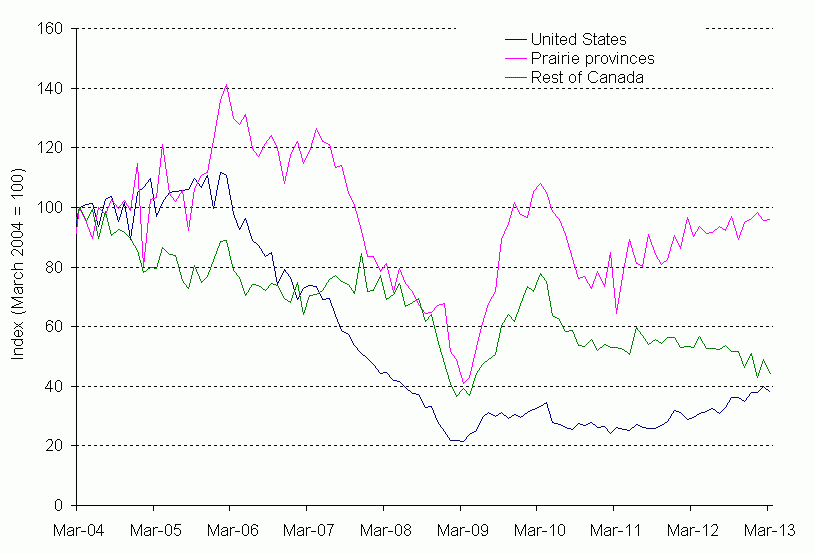Selective Cuttings
North American construction trends
May 30, 2013
Much has been made of the unexpected resiliency of Canadian single-family housing construction relative to that of the U.S., but apparent Canadian stability is an artefact of national aggregation. Outside of the Prairie provinces, the Canadian single-family construction sector resembles the U.S. experience. An index of single-family housing starts allows for a relatively straightforward comparison of construction trends in these markets.
North American single-family housing construction (2004-2013)
As of March 2013, single-family housing construction in non-prairie Canada is only 44% of its March 2004 level. This is similar to the U.S. figure of 38% for the same period. The primary difference between the single-family house construction decline in Canada outside the Prairies and the U.S. is the suddenness of the decline. In the Prairie provinces, however, construction sits at 96%, and rising. The Prairie provinces are a strong factor in maintaining the performance of Canada’s national housing construction figures.
Alternatively, one could consider single-family home construction relative to the low point in housing construction (March 2009), to compare how these regions have recovered from the depths of the housing bust. The Prairies are up 134% (and rising), the U.S. is up 76% (and rising) but the rest of Canada is only up 12% (and falling). Indeed, it seems likely that the U.S. construction recovery (relative to March 2004) will surpass Canada outside the prairies before the end of summer 2013.
The resiliency of Prairie construction appears highly likely to result from a resource boom in these provinces, including (but not limited to) energy projects and potash development. Plentiful employment is a primary precondition for a strong housing market, and the Prairie provinces have a very healthy unemployment rate (below 5%), compared to above 8% elsewhere in Canada.
Given that single family construction and renovation account for approximately two-thirds of Canadian softwood lumber consumption, the differing regional rates of single-family housing recovery (along with fibre supply changes and new export markets) could be a factor in explaining the divergent experiences of recovery in the Canadian forest sector in recent years. Domestic markets account for only 17% of B.C. production, so it makes sense to look primarily to export trends to explain the recovery in that province. But elsewhere in Canada, 60% of softwood lumber is shipped to domestic markets, and the vast majority of the rest is shipped to U.S. markets. It is therefore not surprising that recovery has been strong in B.C. (access to Asia) and the Prairies (booming domestic demand) but relatively weak elsewhere (weak domestic demand).

